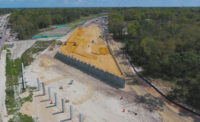“We, as a company, certainly see it as something that’s going to be necessary if state DOTs are going to get their infrastructure needs met,” he says, adding that FDOT’s gambit is likely the first such move.
“This may just be the first card to be played,” Morgan says. “You will probably see some more DOTs come out with some larger packages like this.”
Toll-Funded Capacity Increases
Beyond the immediate acceleration, FDOT is also planning to move forward with a rapid expansion of its “managed lanes” concept, in which tolled lanes are added to existing freeways as a way of boosting capacity.
The recently completed I-95 Express project in Miami-Dade County added toll lanes with variable-priced tolling. Approximately 22,000 drivers use the tolled lanes daily, and the average travel speed on the adjoining general-use lanes during “rush hour” has increased by 20 mph, FDOT says.
Prasad says the agency will develop a series of managed lanes throughout the state in an effort to significantly expand interstate highway capacity over the next several years.
“That’s the idea,” he said. First in line will be portions of Interstate 75 in south Florida, a project with a cost approaching $500 million, according to the secretary. Next up could be a stretch of Interstate 4 in Orlando, a project he estimates at about $2.4 billion.
“That’s a huge project,” he said. “We are doing a traffic and revenue study currently to see what the managed- lanes system can generate on I-4. But I believe we can deliver I-4 managed lanes within the next couple of years.”
Beyond that, Prasad mentioned sections of I-4 and I-75 in Tampa, I-95 in Jacksonville and I-110 in the Florida panhandle as possible candidates for future managed-lanes projects.






Post a comment to this article
Report Abusive Comment